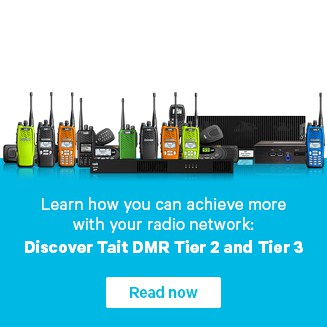Introduction to DMR
Call Types and Features
Voice Calls
Trunked radio systems enable radio users to make two main types of calls on a DMR system. The first main type of call is Voice Calls. Voice calls can be individual calls (one to one), or talk group calls (one to many). Calls can also be made to dispatchers or through telephone gateways.
Individual Calls
What: This call is a one to one call between one subscriber unit and another, or it could be from one subscriber unit to the dispatcher. As there are only two people involved in this call, it is a private call.
How: An individual call is made by dialing the individual’s number from the keypad of the subscriber unit or choosing their ID from a menu. A portable radio can be configured to ring like a cell phone, and to answer, the user pushes the PTT switch. Call timers are generally lower for individual calls than for group calls to keep conversations to a minimum and reserve system time. Once a call finishes, the units involved in the call return to their local control channel.
Talk Group Calls
This call is the most often used voice call.
What: A talk group consists of people with a common interest. They can be fixed by the network operator, or they can come together for a certain situation.
– There are other types of talk groups such as a selectable or subscribed group, where the user can select it to join another team or to make contact with outside groups, and scan groups which is a group used to monitor calls to other groups. A scan group will listen to calls made to their group.
How: When a talk group is called by an individual, the system assigns a channel on one side or multiple sides for that call to go ahead. The group can be permanent, which means that it’s programmed into each individual subscriber unit. Permanent groups are groups that are fixed in the radio’s memory. A subscriber unit will always respond to a call to a permanent group. They’re typically used for emergency or for calls that are significant to a team. If a subscriber unit is idle on a channel and a call to the permanent group is made, the radio will respond.
Types of Group Calls:
- Conference call – Everybody in the call can respond and communicate. During a conference call, each user sees on their LCD a display which shows who made the call. When making a conference call, a go ahead tone is heard. Each member of the talk group sees the ID of the caller.
- Broadcast call – In this call only the person making the call can transmit, people must listen. They don’t have the ability to retransmit on the channel. When a broadcast call is made, the users, when they try to respond, will get a message on their screen saying “Cannot transmit”.
Telephone and Gateway Calls
What: This can be a call through a gateway to a telephone system or through a gateway to a dispatcher. It could also be a call through a gateway to a conventional analog radio network.
How: A telephone gateway will have an assigned number that a user has to call first. This will give them dial tone, and then access to the telephone network. The gateway that connects to a conventional network will have a group number assigned to it, so a user will dial that group number which accesses the conventional network via the gateway.
In a DMR system, dispatchers have a unique ID just like every other subscriber unit. So a user calling a dispatcher will call that unique number. In the same way, a number is dialed for a user to access the conventional network. This is typically a group number assigned to the conventional gateway.
 Radio Academy
Radio Academy





